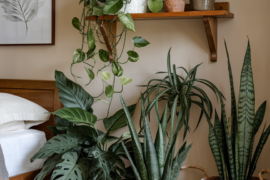Plants aren’t just beautiful—they can also contribute to a healthier, more restful sleep and improve your overall well-being. Bedroom plants have the power to cleanse the air, reduce stress, and create a calming ambiance. Whether you have a small apartment or a spacious bedroom, incorporating the right plants can transform your space into a sanctuary of tranquility. Here’s how to choose and care for bedroom plants that promote healing and wellness.

1. The Benefits of Bedroom Plants
- Air Purification: Plants like the snake plant, spider plant, and peace lily are known for their ability to filter toxins from the air. They help reduce airborne pollutants and improve indoor air quality, making breathing easier as you sleep.
- Stress Reduction: Greenery in the bedroom can lower stress levels and promote relaxation. The sight of lush plants has a calming effect, which can help you wind down after a long day.
- Humidify the Air: Certain plants, such as aloe vera and ferns, release moisture into the air, which can help maintain humidity levels in the bedroom. This is particularly beneficial in dry climates or during the winter months when air tends to be dry.
- Enhance Sleep Quality: Studies have shown that having plants in the bedroom can improve sleep quality. The calming effect of greenery can aid in falling asleep faster and enjoying a deeper, more restful sleep.
2. Top Bedroom Plants for Healing

Snake Plant (Sansevieria)
- Benefits: This hardy plant is excellent for air purification and can thrive in low light, making it perfect for the bedroom.
- Care Tips: Snake plants prefer indirect sunlight and should be watered sparingly—allow the soil to dry out completely between waterings.

Spider Plant (Chlorophytum comosum)
- Benefits: Known for its air-purifying qualities, spider plants are easy to care for and can tolerate a range of lighting conditions.
- Care Tips: They thrive in bright, indirect light but can also do well in lower light conditions. Water them when the soil feels dry.

Peace Lily (Spathiphyllum)
- Benefits: Peace lilies are beautiful and effective at removing toxins from the air. They also add a touch of elegance to any bedroom.
- Care Tips: These plants need moderate to low light and regular watering. They like to dry out slightly between waterings.

Aloe Vera (Aloe barbadensis miller)
- Benefits: Aloe vera is not only soothing for burns but also helps to humidify the air in your bedroom.
- Care Tips: Aloe vera prefers bright, indirect light and should be watered sparingly, allowing the soil to dry out between waterings.

Ferns (Nephrolepis exaltata)
- Benefits: Ferns are excellent at adding a sense of lushness to your bedroom and can boost indoor humidity.
- Care Tips: Ferns prefer bright, indirect light and moist soil. They thrive in steamy bathrooms or in a kitchen window.

3. Placement Tips
- Near the Bed: Place smaller plants like succulents, snake plants, or spider plants on your nightstand or dresser. These plants can serve as gentle reminders of calm and wellness right before sleep.
- Windowsill or Shelves: Larger plants like peace lilies, aloe vera, or ferns can be placed on a windowsill or shelf to benefit from indirect light. This also keeps them out of the way but still close enough to have a positive impact.
- By the Window: If you have a sunny bedroom, consider placing light-loving plants like succulents or spider plants near a window. This helps them thrive and contribute positively to the room’s atmosphere.
- Avoid Direct Sunlight: Keep plants away from direct sunlight, as excessive light can cause their leaves to burn or fade. Opt for filtered or indirect light to maintain their health.

4. Care and Maintenance
- Watering: Most bedroom plants prefer slightly drier conditions than other indoor plants. Water sparingly, allowing the soil to dry out between waterings. Overwatering can lead to root rot, so it’s important to monitor the moisture level.
- Light Requirements: Match the plant’s light needs with the conditions in your bedroom. Some plants thrive in low light (like snake plants), while others require moderate or bright, indirect light (like peace lilies and ferns).
- Cleaning: Dusting the leaves periodically will help the plant photosynthesize more effectively and keep it looking vibrant. Wipe the leaves gently with a damp cloth.
- Repotting: As plants grow, they may outgrow their pots. Repotting into a slightly larger container will provide the plant with more room to grow. This should be done every 2-3 years.

5. Additional Tips for a Healing Bedroom Environment
- Create a Relaxing Ambiance: Pair your bedroom plants with other calming elements like soft linens, an essential oil diffuser, and gentle lighting to enhance the healing environment.
- Avoid Strong Scents: Some people may find certain plant scents overpowering. If you or someone else in your household is sensitive, opt for plants without a strong fragrance or place them in less central locations.
- Mindful Interaction: Spend time with your plants. Water them, trim any dead leaves, and talk to them occasionally. This connection can enhance their beneficial effects on your well-being.
Final Thoughts
Bedroom plants can have a powerful impact on your health and well-being by purifying the air, reducing stress, and promoting relaxation. Whether you’re looking for a specific type of plant or just adding a few leafy greens to your decor, these tips will help you create a soothing, healing bedroom environment. Embrace the natural beauty of plants to foster a peaceful sleep and a more balanced lifestyle.
Which of these bedroom plants are you excited to try in your space? Share your thoughts and experiences in the comments below!







Leave a Reply